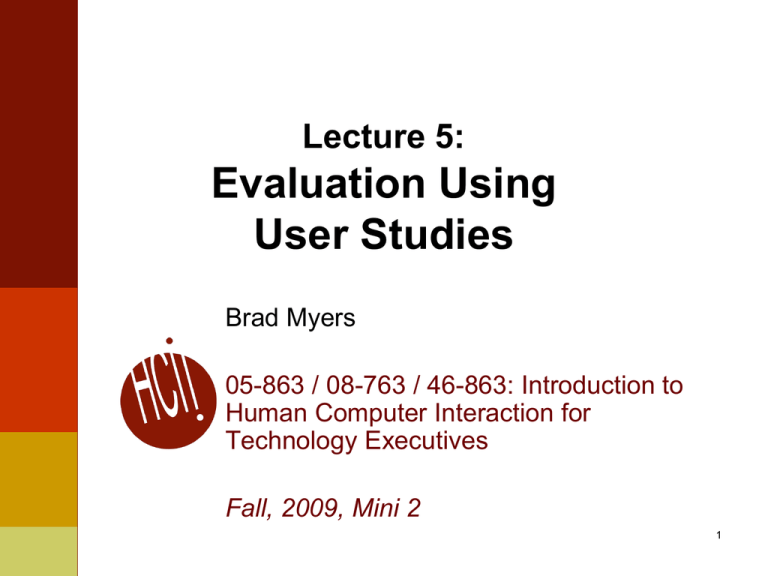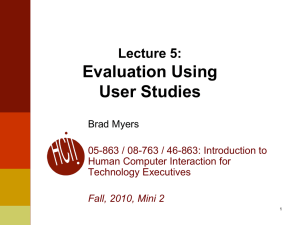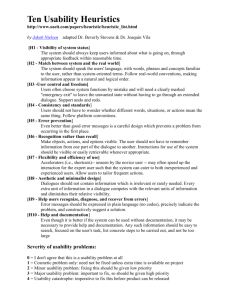Human-Computer Interaction in eCommerce
advertisement

Lecture 5: Evaluation Using User Studies Brad Myers 05-863 / 08-763 / 46-863: Introduction to Human Computer Interaction for Technology Executives Fall, 2009, Mini 2 1 Why Evaluate with User Studies? Following guidelines never sufficient for good UIs Heuristic analysis by experts not sufficient Experts are not the same as users Experts will generate long list of issues Which are the important problems? Experts miss issues Need both good design and user studies (Similar to users with CI) Good designers Average designers Quality, before and after user tests 2 “Don’ts” of User Studies Don’t test whether it works (quality assurance) Don’t have experimenters evaluate it – get users Don’t ask user questions. Not an “opinion survey.” Instead, watch their behavior. Don’t test with groups: see how well site works for each person individually (not a “focus group”) Don’t train users: want to see if they can figure it out themselves. 3 Issue: Reliability Do the results generalize to other people? If comparing two systems Individual differences Up to a factor of 10 in performance Statistics for confidence intervals, p<.01 But rarely are doing A vs. B studies Also, small number of users cannot test an entire site Just a sample 4 Issue: Validity Did the study measure what we wanted? Wrong users “Confounding” factors, etc, Issues which were not controlled but not relevant to study Other usability problems, setting, etc. Ordering effects Learning effects Too much help given to some users 5 Make a Test Plan Goals: Formative – help decide features and design CIs Summative – evaluate system Now Pilot tests Preliminary tests to evaluate materials, look for bugs, etc. Test the instructions, timing Users do not have to be representative 6 Test Design “Between subjects” vs. “within subjects” For comparing different conditions Within: Each user does all conditions Removes individual differences Add ordering effects Between Each user does one condition Quicker for each user But need more users due to huge variation in people Randomized assignment of conditions To people, or order 7 Performance Measurements Efficiency, learnability, user’s preference Time, number of tasks completed, number of errors, severity of errors, number of times help needed, quality of results, emotions, etc. Can instrument software to take measurements Decide in advance what is relevant Or try to log results “live” or from videotape Emotions and preferences from questionnaires and apparent frustration, happiness with system 8 Questionnaire Design Collect general demographic information that may be relevant Age, sex, computer experience, etc. Evaluate feelings towards your product and other products Important to design questionnaire carefully Users may find questions confusing May not answer the question you think you are asking May not measure what you are interested in 9 Problematic Questionnaire 10 Questionnaire, 2 “Likert scale” Propose something and let people agree or disagree: The system was easy to use: “Semantic differential scale” Two opposite feelings: Finding the right information was: agree disagree 1 .. 2 .. 3 .. 4 .. 5 difficult easy -2 .. -1 .. 0 .. 1 .. 2 If multiple choices, rank order them: Rank the choices in order of preference (with 1 being most preferred and 4 being least): Interface #1 Interface #2 Interface #3 Interface #4 (in a real survey, describe the interfaces) 11 Subject ID: ____________1. Please rank order your preference, using 1 for most preferred and 6 for least: An Experimental Study on various input techniques Survey example Questionnaire Mouse Tapping on the SmartBoard Using a Laser Pointer in one hand with the button in the other Using a Laser Pointer built into a Palm (Symbol) device Using a stylus on the PocketPC device Remote control joystick provided with the projector 2. Please rate your proficiency in using computers. Never used before 0 Please complete the following questionnaire. questions. Novice 1 Expert 2 3 4 5 6 7 Please feel free to ask any 3. Please rate your proficiency in using a Palm Pilot or other PDA. Never used before 0 Novice 1 Expert 2 3 4 5 6 7 1. Please rate each input method. 4. Please rate your proficiency in using a laser pointer in general (not necessarily tracked by the computer). 1. Mouse Never used before terrible -3 very poor poor -2 OK -1 good 0 very good 1 2 great 3 2. Tapping on the SmartBoard 0 1 -3 very poor -2 poor OK -1 good 0 very good 1 2 great -3 very poor -2 poor OK -1 good 0 very good 1 2 0 great -3 -2 poor OK -1 good 0 1 3 -3 very poor -2 poor -1 6 7 Novice 1 Expert 2 3 4 5 6 7 No 7. Please supply some information about yourself: very good 2 Female Age: great 3 8. Please write down any other comments or suggestions for improvement: __________________________________________________________________________ 5. Using a stylus on the PocketPC device terrible 5 Yes, I have a: Male very poor 4 6. Do you own a Palm Pilot or other Personal Digital Assistant (PDA)? If so, which model? 4. Using a Laser Pointer built into a Palm (Symbol) device terrible 3 3 3. Using a Laser Pointer in one hand with the button in the other terrible Expert 2 5. Please rate your proficiency in using a touch sensitive whiteboard like the SmartBoard. Never used before terrible Novice OK good 0 1 6. Remote control joystick provided with the projector very good 2 great 3 __________________________________________________________________________ __________________________________________________________________________ 12 __________________________________________________________________________ - End - Videotaping Often useful for measuring after the test Useful for demonstrating problems to developers, management Compelling to see someone struggling Facilitate Impact analysis But very slow to analyze and transcribe Which problems will be most important to fix? How many users and how much time wasted on each problem But careful notetaking will often suffice when usability problems are noticed 13 “Think Aloud” Protocols “Single most valuable usability engineering method” Get user to continuously verbalize their thoughts Find out why user does things What thought would happen, why stuck, frustrated, etc. Encourage users to expand on whatever interesting But interferes with timings May need to “coach” user to keep talking Unnatural to describe what thinking Ask general questions: “What did you expect”, “What are you thinking now” Not: “What do you think that button is for”, “Why didn’t you click here” Will “give away” the answer or bias the user Alternative: have two test users and encourage discussion 14 Getting Users Should be representative If multiple groups of users Issues: Representatives of each group, if possible Managers will pick most able people for testing Getting users who are specialists E.g., doctors, dental assistants Maybe can get students, retirees Paying users Novices vs. experts Very different behaviors, performance, etc. 15 Number of test users About 10 for statistical tests As few as 5 for evaluation Can update after each user to correct problems But can be misled by “spurious behavior” of a single person Accidents or just not representative Five users cannot test all of a system 16 Number of users, cont. Jared Spool claims, for large and complete web sites Only found 35% of problems after 5 users Needed about 25 users to get 85% of the problems Jared Spool and Will Schroeder, “Testing Web Sites: Five Users is Nowhere Near Enough,” SIGCHI’2001 Extended Abstracts, pp. 285-286. 17 Ethical Considerations No harm to the users Emotional distress Emphasize system being tested, not user Highly trained people especially concerned about looking foolish Don’t use terms like “subject” Results of tests and users’ identities kept confidential Stop test if user is too upset At end, ask for comments, explain any deceptions, thank the participants At universities, have “Institutional Review Board” (IRB) 18 Milgram Psychology Experiments Stanley Milgram 1961-1962 Study created emotional distress Subject (“teacher” T) told by experimenter (E) to shock another person ("Learner" L, an actor) if L gets answers wrong > 65% of subjects were willing to give apparently harmful electric shocks – up to 450 volts – to a pitifully protesting victim Some subjects needed significant counseling afterward http://www.stanleymilgram.com/ Image from Wikipedia 19 Prepare for the Test Set up realistic situation Write up task scenarios Write detailed script of what you will say PRACTICE Recruit users 20 Who runs the experiment? Trained usability engineers know how to run a valid study But useful for developers & designers to watch Called “facilitators” Good methodology is important 2-3 vs. 5-6 of 8 usability problems found Available if system crashes or user gets completely stuck But have to keep them from interfering Randy Pausch’s strategy Having at least one observer (notetaker) is useful Common error: don’t help too early! 21 Where Test? Usability Labs Cameras, 2-way mirrors, specialists Separate observation and control room Should disclose who is watching Having one may increase usability testing in an organization Can usually perform a test anywhere Can use portable videotape recorder, etc. 22 Test Tasks and Test Script (Covered in CI lecture) Task design is difficult part of usability testing Representative of “real” tasks Sufficiently realistic and compelling so users are motivated to finish Can let users create their own tasks if relevant Appropriate coverage of UI under test Developed based on task analysis, scenarios Short enough to be finished, but not trivial Have an explicit script of what will say 23 Stages of a Test Preparation Introduction Make sure test ready to go before user arrives Say purpose is to test software Consent form Give instructions Pre-test questionnaire Write down outline to make sure consistent for all users Running the test Debriefing after the test Post-test questionnaire, explain purpose, thanks 24 Introduce the Participants to the Observation Introduce yourself Ask them if they are willing to hear your “pitch” for participating in a study Describe the purpose in general terms Explain the terms of the study and get consent Give them consent form & get signature Ask them background questions 25 Conduct the Observation Introduce the observation phase Instruct them on how to do a think aloud Final instructions (“Rules”) You won’t be able to answer Qs during, but if questions cross their mind, say them aloud If you forget to think aloud, I’ll say “Please keep talking” 26 Cleaning up After a Test For desktop applications Remove old files, recent file lists, etc. Harder for tests of web sites: In real tests of web sites, need to remove history to avoid hints to next user Browser history, “cookies”, etc. 27 Analyze Think-Aloud Data NOT just a transcription of the tape. Establish criteria for critical incidents Record critical incidents and other observations (old: UAR Template): http://www.cs.cmu.edu/~bam/uicourse/UARTemplate.doc New: Form with rows: http://www.cs.cmu.edu/~bam/uicourse/UserTestReport_template1.docx 28 Critical Incident Technique in Human Factors Definition Flanagan, (1954), Psychological Bulletin, 51 (4), 327-358. “By an incident is meant any observable human activity that is sufficiently complete in itself to permit inferences and predictions to be made about the person performing the act. To be critical, an incident must occur in a situation where the purpose or intent of the act seems fairly clear to the observer and where its consequences are sufficiently definite to leave little doubt concerning its effects.” (p. 327) “Such incidents are defined as extreme behavior, either outstandingly effective or ineffective with respect to attaining the general aims of the activity.” (p. 338) Origin: Aviation Psychology Program during WWII 29 Analyzing the data Numeric data Example: times, number of errors, etc. Tables and plots using a spreadsheet Look for trends and outliers Organize problems by scope and severity Scope: How widespread is the problem? Severity: How critical is the problem? 30 Scope and Severity Separately Proportion of users experiencing the problem Impact of the problem on the users who experience it Few Many Small Low Severity Medium Severity Large Medium Severity High Severity 31 Composite Severity Ratings Probably easier to use: (From Nielsen: http://www.useit.com/papers/heuristic/severityrating.html 0 – not a real usability problem 1 – cosmetic problem only–need not be fixed 2 – minor usability problem–low priority 3 – major usability problem–important to fix 4 – usability catastrophe—imperative to fix before releasing product 32 Write a Summarizing Report “Executive” summary Conceptual re-designs are most important If just “tuning”, then a “top ten” list Levels of severity help rank the problems “Highlights” video is often a helpful communications device 33 What to do with Results Modify system to fix most important problems Can modify after each user, if don’t need statistical results No need for other users to “suffer” But remember: user is not a designer 34





